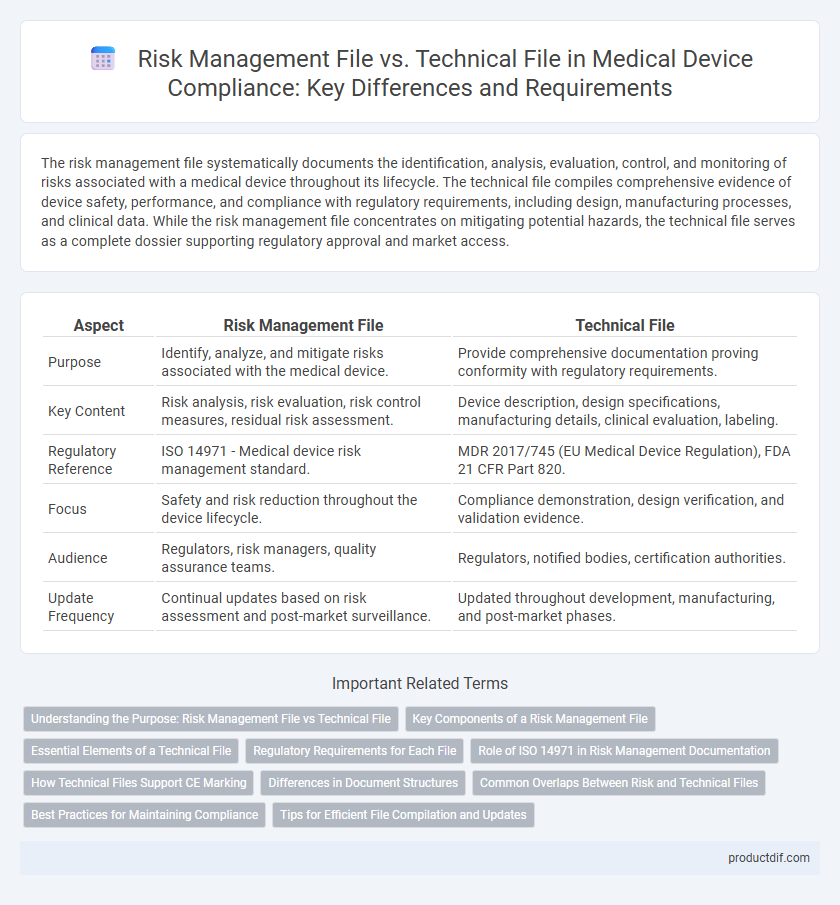The risk management file systematically documents the identification, analysis, evaluation, control, and monitoring of risks associated with a medical device throughout its lifecycle. The technical file compiles comprehensive evidence of device safety, performance, and compliance with regulatory requirements, including design, manufacturing processes, and clinical data. While the risk management file concentrates on mitigating potential hazards, the technical file serves as a complete dossier supporting regulatory approval and market access.
Table of Comparison
| Aspect | Risk Management File | Technical File |
|---|---|---|
| Purpose | Identify, analyze, and mitigate risks associated with the medical device. | Provide comprehensive documentation proving conformity with regulatory requirements. |
| Key Content | Risk analysis, risk evaluation, risk control measures, residual risk assessment. | Device description, design specifications, manufacturing details, clinical evaluation, labeling. |
| Regulatory Reference | ISO 14971 - Medical device risk management standard. | MDR 2017/745 (EU Medical Device Regulation), FDA 21 CFR Part 820. |
| Focus | Safety and risk reduction throughout the device lifecycle. | Compliance demonstration, design verification, and validation evidence. |
| Audience | Regulators, risk managers, quality assurance teams. | Regulators, notified bodies, certification authorities. |
| Update Frequency | Continual updates based on risk assessment and post-market surveillance. | Updated throughout development, manufacturing, and post-market phases. |
Understanding the Purpose: Risk Management File vs Technical File
The Risk Management File documents the identification, assessment, and mitigation of hazards associated with a medical device throughout its lifecycle, ensuring patient safety and regulatory compliance. The Technical File compiles comprehensive evidence of the device's design, manufacturing, and performance, demonstrating conformity with applicable standards and regulations. Together, these files support regulatory submissions and audits by providing a detailed overview of safety measures and technical compliance.
Key Components of a Risk Management File
A Risk Management File systematically documents hazard identification, risk analysis, risk evaluation, and risk control measures for a medical device. It includes detailed records of risk-benefit analysis, verification of implemented controls, and plans for post-market surveillance linked to risk management activities. This file complements the Technical File by focusing specifically on patient safety and compliance with ISO 14971 standards.
Essential Elements of a Technical File
A Technical File in medical device regulation comprises detailed documentation demonstrating compliance with applicable standards, including device description, design specifications, manufacturing processes, and clinical evaluation data. It must include risk management reports aligning with ISO 14971 to identify and mitigate potential hazards throughout the device lifecycle. Essential elements also cover labeling, instructions for use, and post-market surveillance plans to ensure ongoing safety and effectiveness.
Regulatory Requirements for Each File
The Risk Management File must comply with ISO 14971, demonstrating thorough risk analysis, evaluation, and control measures for medical device safety. The Technical File requires adherence to MDR 2017/745 Annex II, containing detailed documentation on device design, manufacturing, and performance to prove conformity. Regulatory bodies expect the Risk Management File to align with clinical evaluation reports while the Technical File supports overall CE marking and market access compliance.
Role of ISO 14971 in Risk Management Documentation
ISO 14971 provides a structured framework for risk management documentation within the Risk Management File (RMF), ensuring comprehensive identification, evaluation, and control of medical device risks throughout the product lifecycle. The Risk Management File integrates risk analysis, risk evaluation, risk control measures, and residual risk assessment, whereas the Technical File encompasses broader documentation including design, manufacturing, and clinical data. Compliance with ISO 14971 in the RMF supports regulatory submissions by demonstrating systematic risk management aligned with international standards.
How Technical Files Support CE Marking
Technical files provide comprehensive documentation demonstrating compliance with the Medical Device Regulation (MDR) essential for CE marking, including design, risk management, and clinical evaluation data. They support conformity assessment by detailing how risk management processes identified and mitigated hazards associated with the medical device throughout its lifecycle. Robust technical files enable notified bodies to verify safety and performance criteria, facilitating regulatory approval and market access within the European Economic Area.
Differences in Document Structures
The Risk Management File systematically compiles hazard analyses, risk evaluations, and mitigation measures following ISO 14971 standards, emphasizing dynamic risk control processes. In contrast, the Technical File encompasses comprehensive product documentation, including design specifications, clinical evaluations, and regulatory compliance evidence, structured according to MDR Annex II requirements. While the Risk Management File focuses on iterative safety assessments, the Technical File serves as an extensive dossier supporting device conformity and market authorization.
Common Overlaps Between Risk and Technical Files
The Risk Management File and Technical File both document critical safety and performance data for medical devices, often overlapping in areas such as hazard analysis, risk control measures, and verification of mitigation effectiveness. Common elements include identification of potential risks, integration of risk controls into design inputs, and traceability matrices linking risk management activities with design and testing documentation. This overlap ensures comprehensive compliance with regulatory requirements like ISO 14971 and MDR, facilitating robust product safety and market approval.
Best Practices for Maintaining Compliance
Maintaining compliance in medical device documentation requires distinct yet integrated management of the Risk Management File and Technical File, ensuring thorough risk assessment, control measures, and traceability throughout the product lifecycle. The Risk Management File should systematically capture hazard identification, risk analysis, evaluation, control, and residual risk acceptability as per ISO 14971 standards. The Technical File must comprehensively document design, manufacturing processes, clinical evaluations, and conformity assessments, regularly updated to reflect risk management outcomes and regulatory changes for audit readiness.
Tips for Efficient File Compilation and Updates
Organizing a Risk Management File and Technical File for medical devices requires clear documentation of hazard analysis, risk evaluation, and control measures alongside product design and compliance data. Use version control software and standardized templates to streamline updates and ensure traceability of changes in both files. Regular cross-referencing between files minimizes discrepancies, enhancing regulatory audit readiness and reducing compilation time.
Risk management file vs Technical file Infographic

 productdif.com
productdif.com